Chewy mochi filled with smooth lotus biscoff spread and dusted in biscoff cookie crumbs
What is biscoff?
Although most people will be familiar with 'Biscoff', the name 'Lotus' branded their cookie, most people will be less familiar with the traditional origin of this commercialized cookie!
Traditionally called speculoos, speculaas, or spekulatius, these are spiced gingerbread cookies traditionally prepared for St. Nicholas on Christmas day in Belgium and the Netherlands.
This mochi is a combination of cultures! The delicious caramelized cookie spread is combined with chewy mochi for a delicious Asian-fusion treat.

What is mochi?
If you aren't familiar with mochi, mochi is a Japanese treat (wagashi) made from glutinous rice. Traditionally it is pound into a paste with water and enjoyed as it is, rolled in flavorings like roasted soybean powder or filled with fillings like red bean paste.
Mochi that has been stuffed with a filling is called daifuku. Daifuku is a name used to describe any Japanese confection made from mochi and a sweet filling. So technically this is a biscoff daifuku!

Ingredients
- Glutinous rice flour: Aka sweet rice flour. If you have access to shiratamako where you live I highly recommend using that! It's a Japanese glutinous rice flour made from short-grain rice (mochigome). Otherwise, you can use mochiko or Thai-style glutinous rice flour which can be found in almost all Asian grocery stores.
- Granulated sugar: Aka white sugar, is used to sweeten the mochi dough as well as give it a softer texture.
- Cornstarch: Cornstarch helps to thicken the mochi dough as well as give it more structure.
- Whole milk: Milk is used to hydrate the dough as well as add extra fat and protein to the dough, this results in a softer mochi with a smoother mouthfeel. If you want to make this dairy-free you can replace this with water.
- Pink food coloring: I love the look of the pink color in these, but you can omit this if you'd like.
- Vegetable oil: Kneading vegetable oil into the dough not only makes it softer and chewier it also makes it easier to handle as it'll be less sticky.
- Biscoff spread: This makes the mochi biscoff! Depending on your personal preference you can use either smooth or crunchy biscoff. Personally, I like to use smooth biscoff in the center as the outside of the mochi is being rolled in biscoff cookie crumbs.

Frequently Asked Questions
How long do these last?
Mochi are best on the day they're made, so I would recommend eating these as soon as possible. They are the chewiest and softest on the day they're made however they will last up to 3 days when stored in an airtight container on the countertop.
As these are filled with biscoff spread they don't need to be stored in the fridge.
Can I freeze mochi?
When mochis are frozen they will have a slightly different texture once defrosted. They won't be as chewy and a little harder, but still delicious!
If you are freezing these keep in mind that they'll only last up to 2 weeks. Afterward, the defrosted mochi will be too hard to eat.
Can I change the filling?
Yes, you can! You can change the filling to whatever spread you like. A couple of delicious examples include nutella or peanut butter.
Why is my mochi hard?
There are a couple of reasons why your mochi is hard:
- The mochi was overcooked
- Not enough liquid was added to the mochi batter
- The cooked dough had been left uncovered for too long
- The dough hadn't been kneaded for long enough
Why is my mochi so sticky?
There are a couple of reasons for sticky dough:
- Too much liquid was added to the batter
- Not enough oil was added to the cooked dough
- The cooked dough had been overworked

Let's Get Cooking
If you know me you know how much I love biscoff, and as a biscoff lover this was one of the best mochi's I've ever had. I can't wait for you guys
If you liked this recipe make sure to leave me a comment and rating down below, I would love to know how you went.
Also, don't forget to tag me on Instagram @catherine.desserts and hashtag #cattycakes so I can see and share your desserts. Follow me on Facebook, Pinterest, Youtube, and TikTok for more of my baking creations and updates! Until next time... happy caking!
PrintBiscoff Mochi
Chewy mochi filled with smooth lotus biscoff spread and dusted in biscoff cookie crumbs
- Prep Time: 30 minutes
- Cook Time: 5 minutes
- Total Time: 35 minutes
- Yield: 8 Mochi 1x
- Category: Mochi
- Method: Easy
- Cuisine: Asian Fusion
Ingredients
Mochi
- 200g Glutinous rice flour (1 ½ cup)
- 65g Granulated sugar (⅓ cup)
- 40g Corn starch (⅓ cup)
- 360ml Whole milk (1 ½ cup)
- 1 ½ tbsp Vegetable oil
Filling
- 1 cup Lotus biscoff spread, smooth
Assembly
- 10 Lotus biscoff cookies, crushed into a fine dust
Instructions
Mochi
- Combine the glutinous rice flour, sugar, and cornstarch in a medium-sized microwave-safe bowl, and whisk to combine
- Add the milk, and whisk until smooth
- Cover the mochi mixture with cling wrap and microwave for 2 minutes on high
- Uncover and stir
- Then re-cover and microwave for another 2 minutes, the mochi dough should be semi-translucent
- If the mochi is still slightly liquidy/milky re-cover it and microwave at 1-minute intervals until cooked through
- Allow the mochi to cool enough to handle
- Add the vegetable oil and using gloved or oiled hands knead until smooth
- Prepare a baking tray lined with baking paper
- Divide the mochi into 8 equal portions and place on the baking sheet.
Assembly
- Prepare a shallow bowl with cornstarch
- Using oiled or gloved hands flatten a portion of mochi between your palms and pipe a round blob of biscoff into the centre
- Bring the edges of the mochi together to enclose the biscoff and roll it into a ball
- Dust the ball in biscoff cookie crumbs and repeat with the remaining mochi and biscoff
- Enjoy!

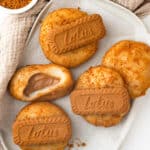
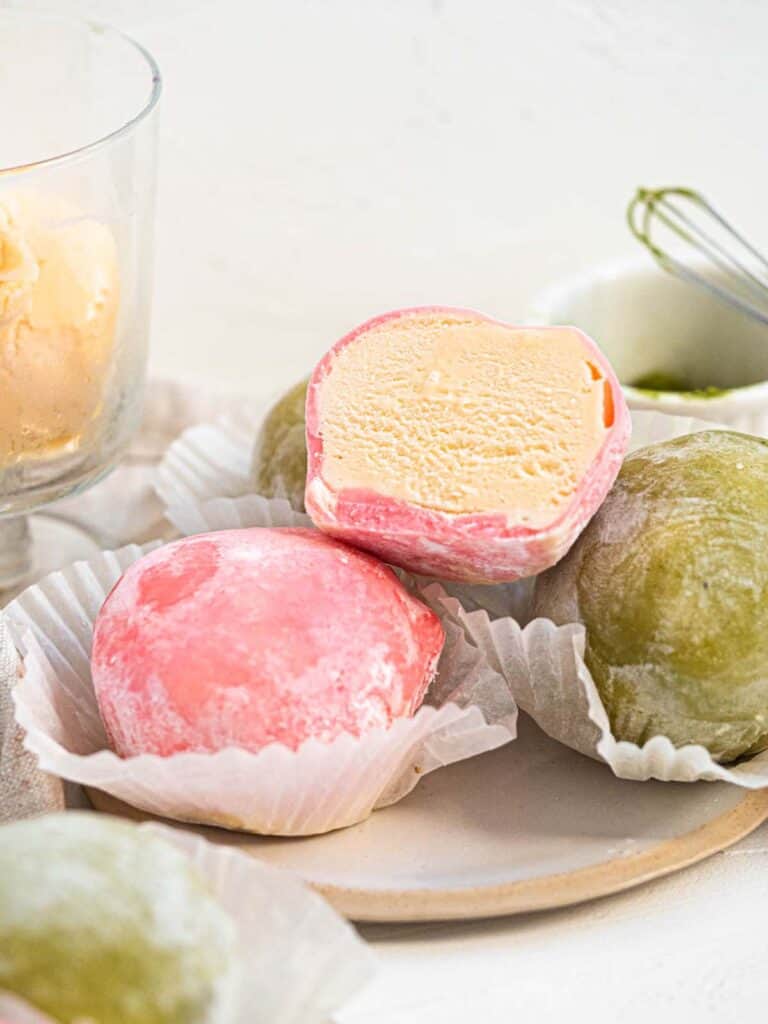
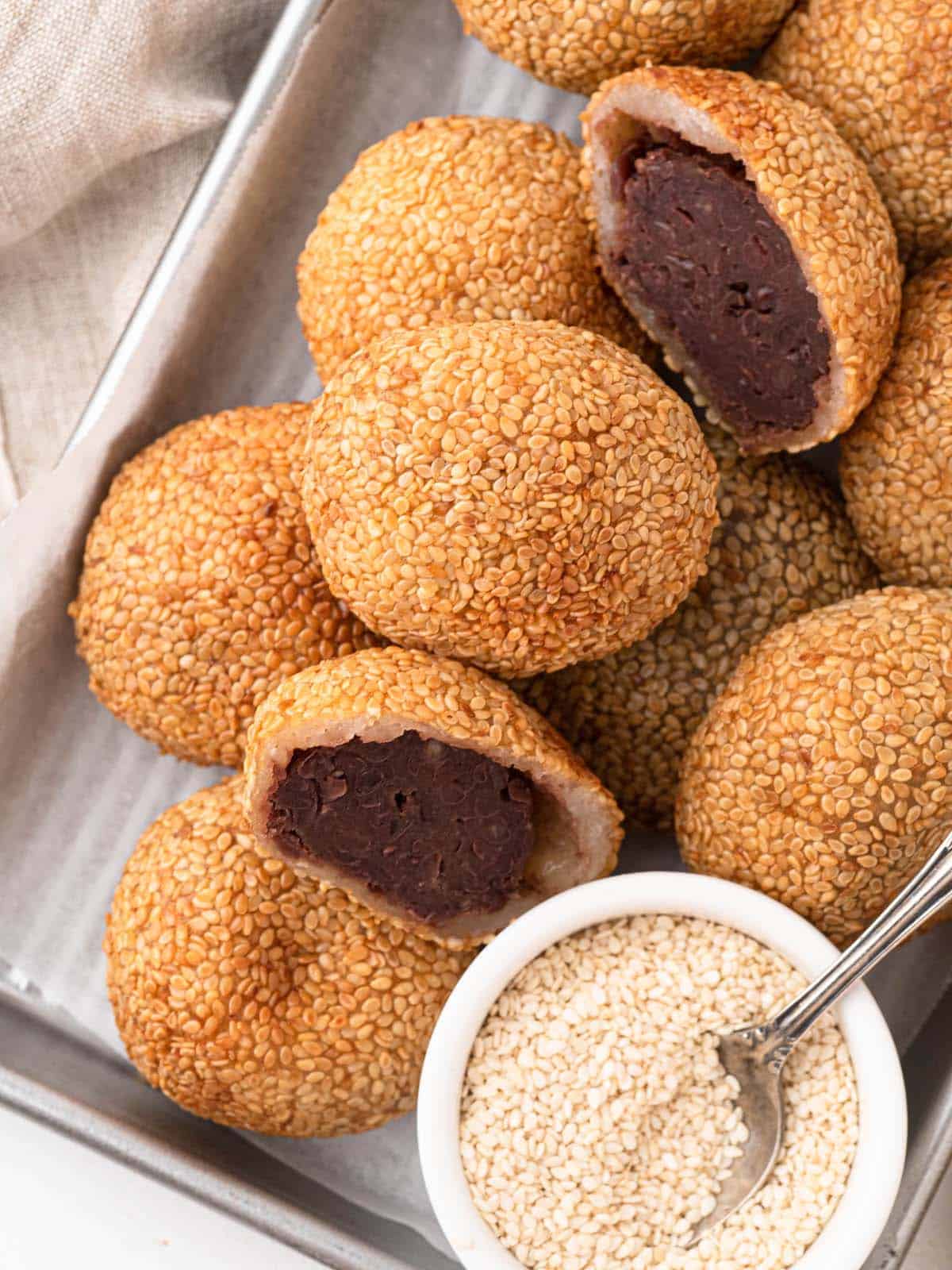

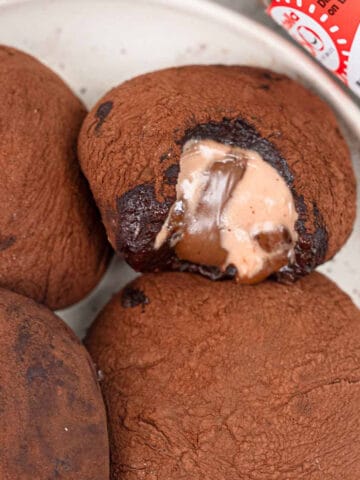
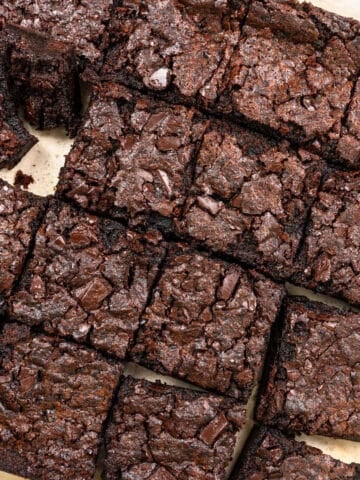
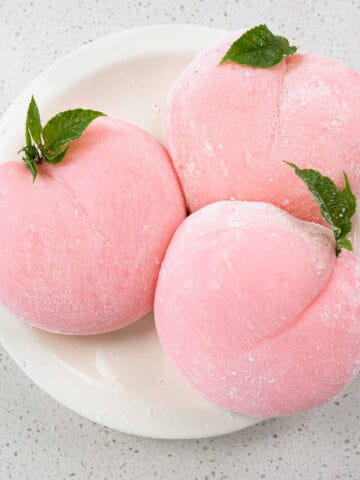
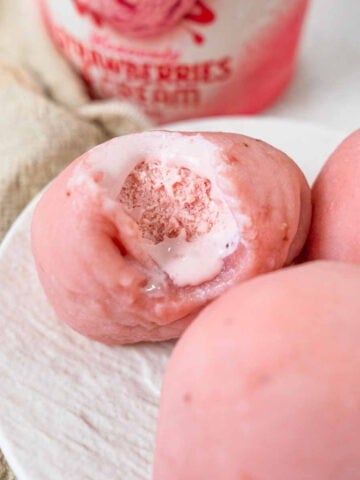
Katie
I tried this today....WOW just wow! So easy and incredibly yummy, thank you for this receipe Catherine!
Carmen
Very easy recipe! Dangerously addictive! I reduced the amount of sugar for the dough by about 20% and I used the crunchy paste for the filling with some big crumbs. Made 25 small (one/two bites) portions. Thank you for the recipe, Catherine!